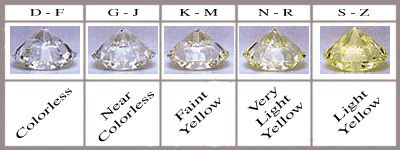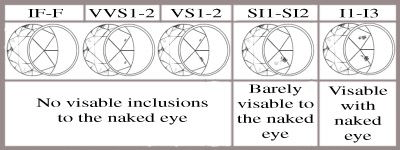
 |
|
Brief Diamond History Diamonds, a girl’s best friend, are a part of history and legend. Kings have sacrificed kingdoms for diamonds, and women have sacrificed their freedom. The Greeks believed that the fire in a diamond reflected the flame of constant love. ---In 1870, the discovery of huge mines in South Africa made diamonds more plentiful and accessible. For the first time, diamonds were available to all diamond lovers, not just royalty! A Diamond Is Born This rare and precious mineral began its journey as carbon buried deep within the earths crust, millions of years ago. Intense heat and pressure caused the crystallization of the carbon into diamond. Then, the eruption of volcanoes forced the diamond embedded rock up to the earth’s crust, where it was mined as diamond ore. It is estimated that 250 tons of ore must be mined, crushed, sorted & re-sorted to find one rough diamond large enough and fine enough to cut into a one-carat gemstone. All diamonds are then classified according to size, shape, and quality, over 2,000 categories in all. The stones of gem quality are then sent to major cutting centers where they are studied and marked for cutting. Finally, they are carefully cut, polished, and sorted. The Four C's To an untrained eye, most finished, polished diamonds will appear quite similar. Yet no two diamonds are actually alike, being individual like snowflakes. Each has its own fingerprint, being comprised of the 4 traits common to all diamonds: cut, color, clarity and carat weight. Cut When a jeweler uses the term "cut", they are referring to both the shape of the stone as well as the proportions. The most common shapes are: Round, Marquise, Pear, Emerald, Oval, Heart, Princess and Radiant. Most diamonds are cut with 58 facets, except the Princess & Radiant. A diamond cutter must examine a rough stone and decide which shape the finished diamond will be, based on the shape of the rough stone, location of its imperfections, its size and how much weight will be lost in the cutting process. When a diamond is properly proportioned and cut, it will give maximum brilliance, refracting the light inside the diamond and bouncing it back up to the eye. When the diamond is cut too deep or too shallow, the light may leak out the bottom of the diamond, reducing the "life" and sparkle. These diamonds are less valuable. Out of all the 4 C's, the cut is the most important. After all, why buy a diamond that doesn't sparkle? The brilliance will depend on proportions, polish, and transparency. Color Color is a major factor in determining a diamonds value. An alphabetical color scale is used to measure the amount of body color visible through the pavilion of the diamond, viewed against a white background, under white lights. Letter grades range from "D" through "Z".
Clarity
Carat Weight Carat is a measure of weight, not size. It is an extremely light unit of measure, weighing just one fifth of a gram. It is derived from the word “carob", a seed so uniform in weight that it became the standard for diamonds. Each carat has 100 "points'. Therefore a 75 point diamond is also called a three-quarter carat diamond. Visit our blog and ask us a question! At www.UGL-USA.blogspot.com
|

